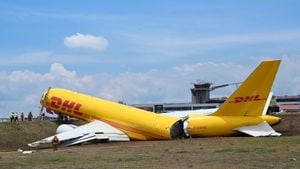Ukraine has effectively repelled a massive drone attack orchestrated by Russia, which marked the largest assault of its kind since the onset of the conflict. On the night of the attack, the Ukrainian defense forces managed to intercept and destroy around 80% of the drones launched at them. This marked a significant achievement for Ukraine’s military, showcasing their growing capabilities and readiness to counter aerial assaults.
According to officials, the drone onslaught began late at night and continued for several hours. These were primarily Iranian-made Shahed drones, which have been utilized by Russian forces throughout the conflict. Despite the nocturnal timings and the sheer volume of drones attempting to breach the airspace, Ukrainian air defense systems remained vigilant and responsive, dowing numerous intruders before they could reach their intended targets.
The effectiveness of Ukraine’s air defenses has been bolstered by the introduction of advanced systems, including the U.S.-made Patriot missile systems and other European artillery, enabling them to detect and intercept drones more efficiently. The rise of drone warfare has escalated risks for civilian safety as well, since many drones can carry explosive payloads capable of inflicting significant damage on residential and commercial infrastructures.
Ukrainian officials noted the strategic importance of this successful defense, emphasizing their commitment to protecting their airspace and citizens. President Volodymyr Zelensky expressed gratitude for the international support, which has included training and supply of aerial defense systems from allied countries. Zelensky’s administration has been heavily reliant on foreign military aid, and recent developments only underscored the need for continued international assistance to bolster their defenses against such aggressive aerial campaigns.
This large-scale drone attack serves to highlight the precarious situation on the ground as the conflict continues to evolve. Analysts suggest this is not merely about territorial integrity, but also about maintaining morale within Ukraine and signaling to the Ukrainian populace and its allies the potential outcomes if defenses fail.
Military expert Oleskiy Danilov remarked, “Each successful interception of these drones acts as both a tactical victory and strategic morale booster for our troops. We are proving we can defend our skies, but we need to be prepared for future waves.” This statement points to the necessity for Ukraine to stay one step ahead, anticipating not only the number but also the sophistication of attacks as both sides strategize for upcoming moves.
Each wave of drone assaults has raised questions about the effectiveness of existing defense measures and how such attacks can be countered successfully. The retract nature of drone warfare plays to the strengths and vulnerabilities of both militaries, creating unique challenges for air defense. Ukraine’s ability to intercept incoming threats minimizes the impact of such assaults but necessitates constant vigilance, training, and updates to their tactical approaches.
Despite this success, there remains considerable concern over the risks posed to civilian life and infrastructure. Drone strikes on urban areas could lead to catastrophic outcomes, and officials remain determined to protect their cities through heightened defense measures and community awareness initiatives.
The sustained and intensified nature of drone attacks reflects the broader strategy adopted by Russia, which has increasingly relied on aerial bombardments to inflict damage on Ukrainian positions and civilian areas alike. Observers indicate this shift is likely to continue, marking a concerning trend where air superiority plays a pivotal role. Conversely, Ukrainian forces must adapt rapidly to counteract these threats, pointing to the essence of agile military strategies.
The international community’s role cannot be ignored as well, with numerous nations pledging military assistance and support. Continuous conversations about bolstering Ukraine’s air defense system resonate at various levels of governance across the globe. Pressure mounts on Western allies to supply more advanced weaponry and support systems as military dynamics evolve.
Local civilian populations are also cognizant of the risks posed by these drone attacks. Many have become accustomed to nightly sirens and have put together emergency kits as proactive measures. Regular updates from officials provide insight not only about military engagements but also reinforce the need for community preparedness.
For those residing within urban areas close to military installations, the situation becomes particularly stressful. The fear of being caught within the crosshairs of aerial attacks has led many to install protective measures and stay abreast of emergency announcements. The psychological toll of constant alertness weighs heavily on citizens, who strive for normalcy amid the chaos.
Responses to these drone attacks have led to concerted efforts to improve both defense and recovery capabilities. The Ukrainian government has been assessing potential improvements, including the enhancement of ground-to-air defense frameworks and the expansion of rapid response initiatives. Every successful interception translates directly to lives saved and infrastructure protected, reinforcing the need for unwavering commitment to defense improvement.
The drone conflict is sure to continue shaping the existing military engagements, and as tensions rise and fall, both sides will adapt their strategies accordingly. Ukraine’s commitment to repelling these attacks firmly places it at the forefront of this aspect of warfare, showcasing their resilience amid prolonged conflict and underlining the significance of international support.
The drone attacks embody the multifaceted nature of this conflict, where technology intersects with warfare, placing Ukraine on the global stage as they navigate not only conventional battlefields but also the skies above. The lessons learned from each encounter will only bolster their defenses moving forward as they continue to strengthen their military capabilities and community support systems.



